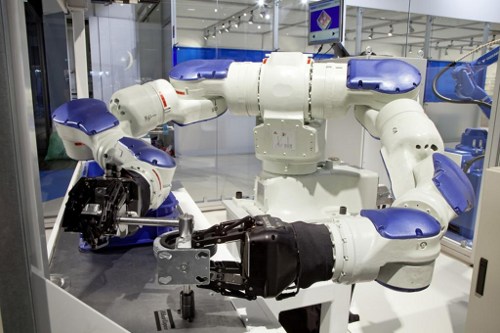 |
| November 26, 2013 | Volume 09 Issue 44 |
Designfax weekly eMagazine
Archives
Partners
Manufacturing Center
Product Spotlight
Modern Applications News
Metalworking Ideas For
Today's Job Shops
Tooling and Production
Strategies for large
metalworking plants
Robomotive humanoid robot gets busy with assembly thanks to 3D vision frame grabber
BitFlow's Neon-CLB PCIe frame grabber is a key component of the 3D-structured light-imaging system deployed in the Robomotive humanoid robot, jointly developed by Yaskawa Motoman, Beltech, and Robotiq.

The Robomotive 3D humanoid robot counts on BitFlow's Neon-CLB PCIe frame grabber for machine vision.
"Humanoid robotic design is oftentimes associated with entertainment, such as the Honda ASIMO," explained Donal Waide, director of sales for BitFlow, Inc. "This is an unfair generalization, as Robomotive and other humanoid robots equipped with 3D vision sensors are today playing an increasing role in industrial automation, including in smaller bin-picking setups where parts are constantly changing and a robotic solution would have been ruled out because of expense just years ago."
The Robomotive is at the forefront of the 3D humanoid robotic movement. Equipped with human-like arms and grippers, it can lift up to 44 lb per arm. Thanks to its 3D vision system, the two arms can work independently or in concordance, plus feature a 7-axis design that provides the flexibility to work with objects of different sizes. It has been cost-effectively deployed in the automation of small batch processes with large mixes of parts, a task once left to humans.
Multiple product-specific grippers and jigs are not necessary with this unit, because the Robomotive is flexible with advanced imaging capabilities and adaptive grippers. Also, users don't need to change the hardware environment with Robomotive; it can be placed in a workstation and trained to do the task a human would do. With conventional robots, time and money is wasted while switching over from different product batches. The Robomotive solution lets the user load a large number of programs depending on the product being assembled. Tasks can be switched easily and quickly.
The 3D vision system is based upon laser triangulation, a scanning method that is insensitive to the reflective surface of materials often found in production, such as copper, brass, zinc plating, aluminium, or stainless steel, as well as shiny, oily surfaces. At the moment, laser triangulation is the best option for robotic guidance. It is a robust, reliable technology that isn't disrupted by lighting variations or reflections. The Robomotive uses a filter on the camera to eliminate extraneous light apart from the laser wavelength. A Peak Detector built inside the camera detects the laser maximum-intensity point, resulting in 10x better detection than can be achieved with a typical center of gravity, obtaining sharper surface details.
The steps for robot guidance begin with gathering a 3D point cloud, which has to be processed to locate the object and its orientation. Only then can Robomotive use the gripper to pick it up. The 3D image has to be "interrogated" to ensure there are no other objects blocking the gripper's path; software defines the gripper of the robot and its landing zone. The landing zone of the gripper can be a cylinder of the diameter of the gripper or a 3D model of the gripper. Defining the zone is based on 3D coordinates, as well as the angle and the plane of the object, but care has to be taken to avoid collisions between the gripper and its surroundings. For the system to work, communication between robot and vision has to be calibrated based on the same coordinates.
The BitFlow frame grabber mitigates the Robomotive's vision system complexities. Using the low-cost Neon-CLB (Camera Link Base cameras only) on a half-size PCIe x4 interface, the demands and costs for the motherboard choice are significantly reduced. It is built on top of BitFlow's FlowThru technology, which provides zero latency access to data, super-low CPU usage, and unlimited DMA destination size. The Neon-CL family can reduce both the system cost and the hardware footprint by its ability to acquire information from up to four cameras.
Source: BitFlow
Published November 2013
Rate this article
View our terms of use and privacy policy
